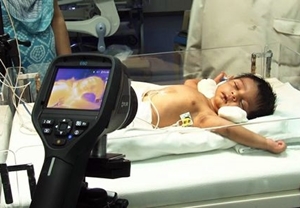6 February 2014. Engineers at Xerox Corporation research centers in Bangalore, India and Webster, New York are testing the feasibility of video sensing combined with data analytics to track the status of patients with chronic conditions. The project is led by Xerox research fellow Lalit Mestha in Webster.
The techniques tested by Xerox use video cameras that capture continuous images of patients with conditions that need constant monitoring, such as cardiovascular and respiratory diseases. The flow of images then are processed through algorithms that convert the images to data representing the patient’s vital signs. The use of video makes it possible to capture these data without intrusive wires or sensors.
For example, the oxygenated blood pumped by the heart makes the skin slightly redder. The video camera can capture these subtle color changes, which may be imperceptible to the human eye. Xerox’s algorithms then can calculate the patient’s heart rate from those images, without attaching a device to the patient.
Xerox’s initial tests were with the neonatal unit at Manipal University Hospital in Manipal, India, to monitor conditions of newborns, but the scope is being expanded to cover other areas of the hospital. Mestha is also testing the system at University of Rochester Medical Center with heart patients, to detect the occurrence of atrial fibrillation, or irregular heartbeat.
If successful, the expanded tests could lead to systems that enable patient monitoring at remote clinics or homes, without specialists immediately on hand. This approach could also reduce risks of infection from attaching intrusive sensors.
Mestha tells more about the video sensing system in the following video.
- Simple, Sensitive Biosensors Derived from Engineered Viruses
- Mid-Air Tactile Sensory Ultrasound Technology Developed
- Wireless Sensor System Detects Occurrence of Elderly Falls
- Stable, Inexpensive Nanoparticle Biosensors in Development
- Smartphone Biosensor Devised to Detect Toxins, Pathogens
* * *


 RSS - Posts
RSS - Posts
You must be logged in to post a comment.